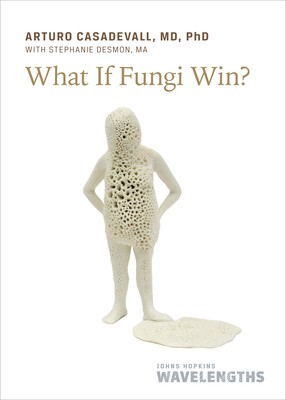
- We will send in 10–14 business days.
- Author: Arturo Casadevall
- Publisher: Johns Hopkins University Press
- ISBN-10: 1421449005
- ISBN-13: 9781421449005
- Format: 12.2 x 17 x 2.3 cm, minkšti viršeliai
- Language: English
- SAVE -10% with code: EXTRA
Reviews
Description
Could fungal pathogens outsmart us before we find ways to combat them?
Humans and fungi share 50 percent of the same DNA. Because we're related, designing drugs to combat the varieties that attack us is a challenge. Meanwhile, in an ever hotter, wetter world, fungi may be finding new ways to thrive, queueing up global outbreak potentials for which no vaccine and woefully few medications exist; some fungi are already finding ways to resist treatment. Among other lifeforms, bats, amphibians, and essential crops are also increasingly threatened by these pathogens.
Enter fungal kingdom frontiersman Dr. Arturo Casadevall, an epidemiologist, professor, and inventor. Casadevall shares how the 1990s AIDS epidemic's fungal complications drove his medical mycology work, how COVID-19's fungal incidences underscored the continuing threat to the immunocompromised, and how he and his Johns Hopkins University laboratory team are discovering ways to counter the threats posed by these smart, hungry combatants.
What If Fungi Win? describes the beneficial roles of fungi along with their mischievous and deadly impacts and illustrates how committed experts like Casadevall are researching ways to save us and our food supplies. In addition to an overview of blights, lichens, molds, mushrooms, rusts, and smuts, readers will learn about:
- how fungi proliferated following the mass dinosaur extinction
- Oregon's ancient 2,384-acre Armillaria ostoyae--Earth's largest organism
- the rye fungus ergot that may have fueled the Salem witch trials
- mushrooms used to create vegan leather and eco-friendly packaging, as well as plastic-consuming fungi
- why it's critical that funding institutions pay attention to fungal risks and aid scientists in their work.
- Author: Arturo Casadevall
- Publisher: Johns Hopkins University Press
- ISBN-10: 1421449005
- ISBN-13: 9781421449005
- Format: 12.2 x 17 x 2.3 cm, minkšti viršeliai
- Language: English English
Could fungal pathogens outsmart us before we find ways to combat them?
Humans and fungi share 50 percent of the same DNA. Because we're related, designing drugs to combat the varieties that attack us is a challenge. Meanwhile, in an ever hotter, wetter world, fungi may be finding new ways to thrive, queueing up global outbreak potentials for which no vaccine and woefully few medications exist; some fungi are already finding ways to resist treatment. Among other lifeforms, bats, amphibians, and essential crops are also increasingly threatened by these pathogens.
Enter fungal kingdom frontiersman Dr. Arturo Casadevall, an epidemiologist, professor, and inventor. Casadevall shares how the 1990s AIDS epidemic's fungal complications drove his medical mycology work, how COVID-19's fungal incidences underscored the continuing threat to the immunocompromised, and how he and his Johns Hopkins University laboratory team are discovering ways to counter the threats posed by these smart, hungry combatants.
What If Fungi Win? describes the beneficial roles of fungi along with their mischievous and deadly impacts and illustrates how committed experts like Casadevall are researching ways to save us and our food supplies. In addition to an overview of blights, lichens, molds, mushrooms, rusts, and smuts, readers will learn about:
- how fungi proliferated following the mass dinosaur extinction
- Oregon's ancient 2,384-acre Armillaria ostoyae--Earth's largest organism
- the rye fungus ergot that may have fueled the Salem witch trials
- mushrooms used to create vegan leather and eco-friendly packaging, as well as plastic-consuming fungi
- why it's critical that funding institutions pay attention to fungal risks and aid scientists in their work.


Reviews